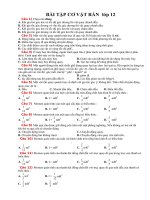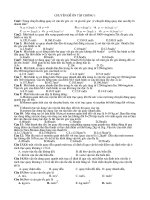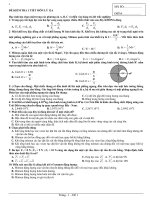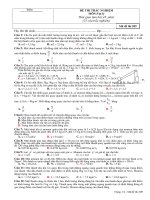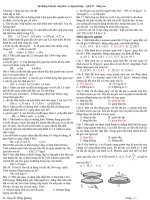slide cơ học vật chất rắn chapter 2 new deformation displacements and strain
Bạn đang xem bản rút gọn của tài liệu. Xem và tải ngay bản đầy đủ của tài liệu tại đây (4.74 MB, 33 trang )
.c
om
ng
co
an
th
cu
u
du
o
ng
Chapter 2: Deformation: Displacements
and strain
TDT University -‐ 2015
CuuDuongThanCong.com
/>
.c
om
h"p://incos.tdt.edu.vn
2.1 General deformations
co
ng
2.2 Geometric construction of small deformation theory
an
2.3 Strain transformation
th
2.4 Principal strains
du
o
ng
2.5 Spherical & Deviatoric strains
2.6 Strain compatibility
cu
u
2.7 Curvilinear strain-displacement relations cylindrical coordinates
2
CuuDuongThanCong.com
/>
.c
om
h"p://incos.tdt.edu.vn
2.1 General deformations
co
ng
2.2 Geometric construction of small deformation theory
an
2.3 Strain transformation
th
2.4 Principal strains
du
o
ng
2.5 Spherical & Deviatoric strains
2.6 Strain compatibility
cu
u
2.7 Curvilinear strain-displacement relations cylindrical coordinates
3
CuuDuongThanCong.com
/>
h"p://incos.tdt.edu.vn
co
ng
This is in contrast to rigid-body motion
where the distance between points
remains the same.
cu
u
du
o
ng
th
an
An elastic solid is said to be deformed or
strained when the relative displacements
between points in the body are changed.
.c
om
Deformations: non-homogeneous
Fig 1. Rigid-body motion
Fig 2. Deformed or strained
4
CuuDuongThanCong.com
/>
h"p://incos.tdt.edu.vn
.c
om
Small Deformation Theory
ng
- Consider two neighboring material points P0 and P
connected with the relative position vector r as shown
in Fig 3.
- Through a general deformation, these points are
mapped to locations P’0 and P’ in the deformed
configuration.
- In linear elasticity, only small deformation theory is
necessary.
P
r
an
co
P0
r'
u0
P0′
Fig 3. General deformation
between two neighboring points
ng
th
P′
u
du
o
Taylor series expansion around point P0 to express the
components of u as
cu
u
f ( ui + Δui ) = f ( ui ) + f ,ui ( ui ) Δui
∂u
∂u
∂u
rx + ry + rz
∂x
∂y
∂z
∂v
∂v
∂v
v = v o + rx + ry + rz
∂x
∂y
∂z
∂w
∂w
∂w
w = wo +
rx +
ry +
rz
∂x
∂y
∂z
u = uo +
CuuDuongThanCong.com
The change in the
relative position vector r
prove
Δr = r′ − r
Δri = ui , j rj
5
/>
h"p://incos.tdt.edu.vn
.c
om
Small Deformation Theory
co
∂u
∂u
∂u
u = u + rx + ry + rz
∂x
∂y
∂z
∂v
∂v
∂v
v = v o + rx + ry + rz
∂x
∂y
∂z
∂w
∂w
∂w
w = wo +
rx +
ry +
rz
∂x
∂y
∂z
ng
f ( ui + Δui ) = f ( ui ) + f ,ui ( ui ) Δui
an
o
P
r
P0
r'
u0
du
o
u
∂u
∂u
∂u
rx + ry + rz
∂x
∂y
∂z
∂v
∂v
∂v
Δry = r ' y − ry = rx + ry + rz
∂x
∂y
∂z
∂w
∂w
∂w
Δrz = r 'z − rz =
rx +
ry +
rz
∂x
∂y
∂z
cu
Δr = r ′ − r
= u − u0
Δrx = r 'x − rx =
CuuDuongThanCong.com
P0′
Fig 3. General deformation
between two neighboring points
ng
th
ui = ui0 + ui, j rj
P′
u
Δri = ui , j rj
/>
h"p://incos.tdt.edu.vn
.c
om
Small Deformation Theory
- Tensor ui,j is called the displacement gradient tensor.
th
an
co
ng
∂u ⎤
∂z ⎥⎥
∂v ⎥ 1
1
=
(
u
+
u
)
+
(ui , j − u j ,i ) = eij + ωij
i, j
j ,i
∂z ⎥ 2
2
⎥
∂w ⎥
∂z ⎥⎦
1
⎧
e
=
⎪ ij 2 (ui , j + u j ,i ) , strain tensor
⎨
1
⎪ωij = (ui , j − u j ,i ) , rotation tensor
⎩
2
ng
∂u
∂y
∂v
∂y
∂w
∂y
du
o
⎡ ∂u
⎢ ∂x
⎢
⎢ ∂v
ui , j = ⎢
∂x
⎢
⎢ ∂w
⎢ ∂x
⎣
u
- Choose ri = dxi, we can write the general result in the form
cu
ui = ui0 + ui , j rj = ui0 + eij dx j + ωij dx j
- Using a dual vector ωi = -1/2 εijkωjk, we have
1 ⎛ ∂u ∂u ⎞
1 ⎛ ∂u ∂u ⎞
1 ⎛ ∂u ∂u ⎞
ω1 = ω32 = ⎜ 3 − 2 ⎟ ; ω2 = ω13 = ⎜ 1 − 3 ⎟ ; ω3 = ω21 = ⎜ 2 − 1 ⎟
2 ⎝ ∂x2 ∂x3 ⎠
2 ⎝ ∂x3 ∂x1 ⎠
2 ⎝ ∂x1 ∂x2 ⎠
ω=
1
( ∇ × u)
2
7
CuuDuongThanCong.com
/>
.c
om
h"p://incos.tdt.edu.vn
2.1 General deformations
co
ng
2.2 Geometric construction of small deformation theory
an
2.3 Strain transformation
th
2.4 Principal strains
2.6 Strain compatibility
du
o
ng
2.5 Spherical & Deviatoric strains
cu
u
2.7 Curvilinear strain-displacement relations cylindrical coordinates
8
CuuDuongThanCong.com
/>
.c
om
h"p://incos.tdt.edu.vn
co
an
(Undeformed Element)
(Rigid Body Rotation)
(Horizontal Extension)
(Vertical Extension)
(Shearing Deformation)
cu
u
du
o
ng
th
Consider the common deformational
behavior of a rectangular element.
Rigid-body motion does not
contribute to the strain field, and
hence does not affect the stresses.
We therefore focus our study on the
extensional and shearing
deformation.
ng
Examples of Continuum Motion & Deformation
Fig 4. Typical deformations of a rectangular element
9
CuuDuongThanCong.com
/>
h"p://incos.tdt.edu.vn
.c
om
Consider a 2D deformation of a rectangular element with original dimensions dx by dy.
Point A(x,y) with displacement components u(x,y) and v(x,y). Point B has displacement
u(x+dx,y) and v(x+dx,y).
co
ng
In small deformation theory,
(Taylor series expansion)
u(x + dx, y) ≈ u(x, y) + (∂u / ∂x)dx
ng
du
o
u
cu
∂u ⎞ ⎛ ∂v ⎞
⎛
A' B' = ⎜ dx + dx ⎟ + ⎜ dx ⎟
∂x ⎠ ⎝ ∂x ⎠
⎝
2
⎛ ∂u ⎞ ⎛ ∂v ⎞
= dx ⎜1 + ⎟ + ⎜ ⎟
⎝ ∂x ⎠ ⎝ ∂x ⎠
⎛ ∂u ⎞
≈ ⎜ 1 + ⎟ dx
⎝ ∂x ⎠
β
v(x,y+dy)
From the geometry
2
D'
C'
th
The normal strain in x-direction
A ' B '− AB
εx =
AB
∂u
dy
∂y
an
2
y
D
C
B'
α
A'
2
dy
∂v
dx
∂x
v(x,y)
A
dx
u(x+dx,y)
B
u(x,y)
x
10
Fig 5. Two-dimensional geometric strain deformation
CuuDuongThanCong.com
/>
h"p://incos.tdt.edu.vn
.c
om
Fig 5. Two-dimensional geometric strain deformation
v(x,y+dy)
∂v
dx
∂x
D’
C’
!
r
∂u
dy
∂y
/
∂u
dx
∂x
ng
th
an
β
co
ng
∂u
dy
∂y
∂v
dy
∂y
dy
D
B’
A’
α
!
r
u
v(x,y)
cu
y
du
o
C
A
dx
B
u(x+dx,y)
u(x,y)
CuuDuongThanCong.com
∂v
dx
∂x
11
/>
.c
om
h"p://incos.tdt.edu.vn
Using AB = dx, the normal strain in x - direction reduces to ε x =
D'
an
C'
β
ng
th
v(x,y+dy)
y
du
o
u
cu
∂u
dy
∂y
co
A second type of strain is
shearing deformation, which
involves angles changes.
Shear strain is defined as the
change in angle between two
originally orthogonal directions
in the continuum material.
Measured in radians, shear
strain is positive if the right
angle between the positive
directions of two axes
decreases.
∂v
∂y
ng
Similarly, the normal strain in y - direction ε y =
∂u
∂x
D
C
B'
α
A'
dy
∂v
dx
∂x
v(x,y)
A
dx
u(x+dx,y)
B
u(x,y)
x
Fig 5. Two-dimensional geometric strain deformation
12
CuuDuongThanCong.com
/>
h"p://incos.tdt.edu.vn
γ xy =
.c
om
Shear strains in x- and y-directions can be defined as
π
2
− ∠C ' A ' B ' = α + β
For small deformations, α≈ tanα and β ≈ tanβ, and then
ng
∂u
∂v
dy
dx
∂u
∂v
∂y
γ xy = ∂x
+
=
+
∂u
∂v
dx + dx dy + dy ∂y ∂x
∂x
∂y
co
∂u
dy
∂y
an
C'
β
ng
y
du
o
γ xy = γ yx
th
v(x,y+dy)
By interchange of x & y, u & v
cu
u
Similarly, we have
∂u
∂v
∂w
εx = , εy = , εz =
∂x
∂y
∂z
∂u ∂v
∂v ∂w
γ xy = + , γ yz = + ,
∂y ∂x
∂z ∂y
∂w ∂u
γ zx =
+
∂x ∂z
CuuDuongThanCong.com
D'
D
C
B'
α
A'
dy
∂v
dx
∂x
v(x,y)
A
dx
u(x+dx,y)
B
u(x,y)
x
Fig 5. Two-dimensional geometric strain deformation
13
/>
h"p://incos.tdt.edu.vn
∂u
∂v
∂w
1 ⎛ ∂u ∂v ⎞
1 ⎛ ∂v ∂w ⎞
1 ⎛ ∂w ∂u ⎞
, e y = , ez =
, exy = ⎜ + ⎟ , e yz = ⎜ +
,
e
=
+ ⎟
⎜
⎟ zx
∂x
∂y
∂z
2 ⎝ ∂y ∂x ⎠
2 ⎝ ∂z ∂y ⎠
2 ⎝ ∂x ∂z ⎠
ng
ex =
.c
om
Using the strain tensor eij, the strain-displacement relations can be expressed as
th
ng
y
du
o
u
eyz
cu
exy
ey
β
v(x,y+dy)
The strain is a symmetric
second-order tensor (eij = eji)
⎡ ex
⎢
e = ⎡⎣eij ⎤⎦ = ⎢eyx
⎢ exz
⎣
D'
C'
an
1
eij = (ui , j + u j ,i )
2
1
e = ⎡⎣∇u + (∇u)T ⎤⎦
2
∂u
dy
∂y
co
Using tensor and matrix notation
exz ⎤
⎥
eyz ⎥
ez ⎥⎦
D
C
B'
α
A'
dy
∂v
dx
∂x
v(x,y)
A
dx
u(x+dx,y)
B
u(x,y)
x
Fig 5. Two-dimensional geometric strain deformation
14
CuuDuongThanCong.com
/>
h"p://incos.tdt.edu.vn
.c
om
Example 2-1: Strain and Rotation Examples
cu
u
du
o
ng
th
an
co
ng
Determine the displacement gradient, strain and rotation tensors for the following displacement
field: u = Ax 2 y , v = Byz , w = Cxz 3 , where A, B, and C are arbitrary constants. Also calculate
the dual rotation vector ω = (1/2)(∇×u).
15
CuuDuongThanCong.com
/>
h"p://incos.tdt.edu.vn
.c
om
Example 2-1: Strain and Rotation Examples
0 ⎤
⎥
By ⎥
3Cxz 2 ⎥⎦
⎡ 2 Axy Ax 2 / 2 Cz 3 / 2 ⎤
1
⎢
⎥
eij = ( ui , j + u j ,i ) = ⎢ Ax 2 / 2
Bz
By / 2 ⎥
2
⎢ Cz 3 / 2 By / 2 3Cxz 2 ⎥
⎣
⎦
2
3
⎡ 0
Ax / 2 −Cz / 2 ⎤
1
⎢
⎥
ωij = ( ui , j − u j ,i ) = ⎢ − Ax 2 / 2
0
By / 2 ⎥
2
⎢ Cz 3 / 2 − By / 2
0 ⎥⎦
⎣
e1
e2
e3
1
1
1
ω = ( ∇ × u ) = ∂ /∂x ∂ /∂y ∂ /∂z = ( − Bye1 − Cz 3e 2 − Ax 2e3 )
2
2
2
Ax 2 y Byz Cxz 3
ng
th
an
Ax 2
Bz
0
cu
u
du
o
⎡ 2 Axy
⎢
ui , j = ⎢ 0
⎢ Cz 3
⎣
co
ng
Determine the displacement gradient, strain and rotation tensors for the following displacement
field: u = Ax 2 y , v = Byz , w = Cxz 3 , where A, B, and C are arbitrary constants. Also calculate
the dual rotation vector ω = (1/2)(∇×u).
CuuDuongThanCong.com
/>
16
.c
om
h"p://incos.tdt.edu.vn
2.1 General deformations
co
ng
2.2 Geometric construction of small deformation theory
an
2.3 Strain transformation
th
2.4 Principal strains
2.6 Strain compatibility
du
o
ng
2.5 Spherical & Deviatoric strains
cu
u
2.7 Curvilinear strain-displacement relations cylindrical coordinates
17
CuuDuongThanCong.com
/>
h"p://incos.tdt.edu.vn
x3′
exz ⎤
⎥
e yz ⎥
ez ⎥⎦
x1
.c
om
exy
ey
e yz
o
x2
co
x1′
ng
⎡ ex
⎢
e = ⎢exy
⎢ exz
⎣
x3
x2′
⎡ e′x
⎢
e′ = ⎢e′xy
⎢ e′xz
⎣
e′xy
e′y
e′yz
e′xz ⎤
⎥
e′yz ⎥
e′z ⎥⎦
th
where
Qij = cos ( xi′, x j )
y
y'
du
o
ng
eij′ = QipQ jq e pq
an
Fig 6. 3D rotational transformation
cu
u
ex + e y e x − e y
⎧
′
x'
⎪ex = 2 + 2 cos 2θ + exy sin 2θ
θ
⎪⎪
e +e e −e
For 2D case, prove ⎨e′y = x y − x y cos 2θ − exy sin 2θ
2
2
⎪
θ
e y − ex
⎪e′xy =
x
sin 2θ + exy cos 2θ
2
⎪⎩
Fig 7. 2D rotational transformation
18
CuuDuongThanCong.com
/>
h"p://incos.tdt.edu.vn
0
.c
om
cosθ
0⎤
0⎥
⎥
1 ⎥⎦
ng
sin θ
⎧e′x = ex cos 2 θ + e y sin 2 θ + 2exy sin θ cosθ
⎪
2
2
⎨e′y = ex sin θ + ey cos θ − 2exy sin θ cos θ
⎪e′xy = −ex sin θ cosθ + e y sin θ cosθ + exy (cos 2 θ − sin 2 θ )
⎩
co
⎡ cosθ
Qij = ⎢ − sin θ
⎢
⎢⎣ 0
ng
th
an
eij′ = QipQ jq e pq
cu
u
du
o
ex + e y e x − e y
⎧
′
e
=
+
cos 2θ + exy sin 2θ
⎪ x
2
2
⎪⎪
ex + e y e x − e y
−
cos 2θ − exy sin 2θ
⎨e′y =
2
2
⎪
e −e
⎪e′xy = y x sin 2θ + exy cos 2θ
2
⎪⎩
19
CuuDuongThanCong.com
/>
.c
om
h"p://incos.tdt.edu.vn
2.1 General deformations
co
ng
2.2 Geometric construction of small deformation theory
an
2.3 Strain transformation
th
2.4 Principal strains
2.6 Strain compatibility
du
o
ng
2.5 Spherical & Deviatoric strains
cu
u
2.7 Curvilinear strain-displacement relations cylindrical coordinates
20
CuuDuongThanCong.com
/>
h"p://incos.tdt.edu.vn
.c
om
eij n j = eni
co
⇒ −e3 + ϑ1e 2 − ϑ2e + ϑ3 = 0
du
o
ng
th
an
ϑ1 = e1 + e2 + e3
ϑ2 = e1e2 + e2e3 + e3e1
ϑ3 = e1e2e3
u
⎡e1 0
eij = ⎢ 0 e2
⎢
⎢⎣ 0 0
cu
=> Principle strains
n1
ng
det ⎡⎣eij − eδ ij ⎤⎦ = 0
n2
0⎤
0⎥
⎥
e3 ⎥⎦
21
CuuDuongThanCong.com
/>
.c
om
h"p://incos.tdt.edu.vn
2.1 General deformations
co
ng
2.2 Geometric construction of small deformation theory
an
2.3 Strain transformation
th
2.4 Principal strains
du
o
ng
2.5 Spherical & Deviatoric strains
2.6 Strain compatibility
cu
u
2.7 Curvilinear strain-displacement relations cylindrical coordinates
22
CuuDuongThanCong.com
/>
h"p://incos.tdt.edu.vn
co
ng
⎛
⎞ 1
1
eij = ⎜ eij − ekkδ ij ⎟ + ekkδ ij
3
⎝
⎠ 3 $
!#
#"##
$ !"
e%
.c
om
In particular applications it is convenient to decompose the strain
tensor into two parts called spherical and deviatoric strain tensors
eˆij
an
th
represents only volumetric deformation
ng
1
e!ij = ekkδ ij
3
du
o
The spherical strain
ij
cu
u
1
The deviatoric strain eˆij = eij − ekkδ ij accounts for changes in shape of material elements
3
Note: principal directions of the deviatoric strain are the same as those of the strain tensor
23
CuuDuongThanCong.com
/>
h"p://incos.tdt.edu.vn
.c
om
Example 2-2: Determine the principle, spherical,
deviatoric strains of the following state of strain
cu
u
du
o
ng
th
an
co
ng
⎡ 2 −2 0 ⎤
eij = ⎢ −2 −4 1 ⎥
⎢
⎥
⎢⎣ 0 1 6 ⎥⎦
24
CuuDuongThanCong.com
/>
.c
om
h"p://incos.tdt.edu.vn
2.1 General deformations
co
ng
2.2 Geometric construction of small deformation theory
an
2.3 Strain transformation
th
2.4 Principal strains
du
o
ng
2.5 Spherical & Deviatoric strains
2.6 Strain compatibility
cu
u
2.7 Curvilinear strain-displacement relations cylindrical coordinates
25
CuuDuongThanCong.com
/>



